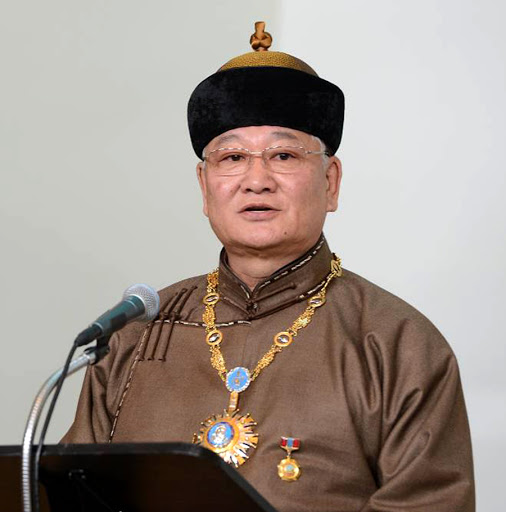Biography
The Mongolian poet G.Mend-Ooyo was born and raised in a nomadic herding family, where his life cons...
G.Mend-Ooyo
Biography
Mend-Ooyo is also active in other areas of Mongolian culture. Since 2006, he has organised an annual exhibition of calligraphy, and between 1990 and 1996 he was involved in the development of the "Mijid Chenrezig" complex, which united Mongolian history and culture. Mend-Ooyo is one of the principal figures in Mongolia involved in the revival of traditional script culture and artistic techniques, and in the study and protection of cultural heritage.
Many commentators have pointed out that, in addition to clearly reflecting in his work the idea of safeguarding the earth and the natural world, Mend-Ooyo expresses with his gentle melodies the exquisite riches of the Mongolian language and of the nomadic worldview. Mend-Ooyo's writings deal with the life of Mongolia’s nomadic herders, their culture and cultural knowledge. In his style and thematic material, he seeks to express the melody and richness of the Mongol language and nomadic society. His works has been translated into over fifty languages.
His novel Gegeenten (The Holy One) received “Golden Feather” annual award for Novel of the Year, Ulaanbaatar, Mongolia 2012. His last novel Shiliin Bogd (Sacred Hill) published in March of 2015.Mend-Ooyo has been awarded many prizes from literary organizations around the world. He received the Poet Laureate (with Golden Crown), highest poetry award from World Congress of Poets, Budapest, Hungary 2009 and has been awarded Grand Prize of the Mihai Eminescu International Academy, Romania 2014.
Curriculum Vitae
1970 Pedagogical College 1974-1978 Mongolian Educational University 1996 Master degree, University of Arts and Cu...
-
Studies and Degrees, Positions
-
Books Poetry
-
Children's Books
-
Research Books
-
Drama and Film
-
Song Lyrics
-
Publications in Mongolian
-
Publications in English
-
Participation in Poetry Events
-
Organizer of Poetry and Cultural Events in Mongolia
-
Articles, Presentations and Speeches
-
Awards and Honors
-
Zen and Poetry Forum
-
International Arts and Calligraphy Exhibition
-
World Poetry Days in Mongolia
-
Essays and Novels
Studies and Degrees, Positions
- 1970 Pedagogical College
- 1974-1978 Mongolian Educational University
- 1996 Master degree, University of Arts and Culture, Mongolia
- 2002 Doctorate of Literature, World Academy of Arts and Culture
- 2008 Professor of Arts and Culture, Institute of International Studies, Mongolian Academy of Sciences
Positions
- 1970-1974 Elementary school teacher, ZamiinUud village, Dornogovi province
- 1978-1988 Editor-in-chief, Arts and Cultural Program, Mongolian Radio and Television
- 1988-1990 Professional writer, Mongolian Writer’s Union
- 1990-1996 Project Leader, Reconstruction of Migjed Janraisag complex in Ulaanbaatar
- 1990-2000 Member of National Committee of UNESCO
- 1990-1998 Executive Director, Vice-President, President, Mongolian Cultural Foundation
- 1998-2000 Chairman, Government Agency, Culture and Arts
- since 2004 Founder and Board member, Mongolian Art Council
- since 2005 Founder and Editor-in-chief of “GUNU”, a culture, literature & poetry magazine
- since 2005 President of the Mongolian Academy of Culture and Poetry
- 2006 President of the XXVI World Congress of Poets in Mongolia.
References
About G.Mend-Ooyo
- The Edwin Mellen Press, “The Interrelationship Humans and the Mongol land in G.Mend-Ooyo’s ALTAN OVOO” by Simon Wickhamsmith, February 2013, 466 pages, 2013, USA, ISBN 9780773444171 Library of Control Number: 2013934153 http://www.mellenpress.com/mellenpress.cfm?bookid=8815&pc=9
- The Wall Street Journal, “Poet fights to maintain Mongolia’s Nomadic culture” by Kit Gillet, Feb, 07, 2013 http://blogs.wsj.com/scene/tag/gombojavyn-mend-ooyo, http://blogs.wsj.com/scene/2013/02/07/at-odds-with-mongolias-modernity-a-poet-seeks-another-way, http://www.kitgillet.com/?p=1569
- The Paris Review, “G.Mend-Ooyo, Ulaanbaatar, Mongolia” series of World Windows, March 1, 2013, by Matteo Pericoli, www.theparisreview.org/blog/tag/g-mend-ooyo/
- International Pen Uyghur Center, “The poet’s achievement, separate from time” by B. Magsarjav, critic, Mongolia, 2011
- Saint-Petersburg State University, “Old legends in modern literature: mystical enchantment of G.Mend-Ooyo’s works” by Maria Petrova, Russia,2010 http://www.ergon-verlag.de/en/
- Caudernos del Matemático, “Mend-Ooyo, el gran poeta contemporáneo de Mongolia” by Justo Jorge Padron, suplemento de Caudernos del Matemático N° 50, ISSN 1132-2403,
- “G. Mend Ooyo's All Shining Moments – a Psalm of Nomadism” Dr. Shaleen Kumar Singh, critic, India, 2009 http://www.creativesaplings.com/old/r3.html, http://www.uyghurpen.org/the_poets_achievement.html, http://muzo.mn/en/1822
- “Homage to g mend ooyo and his book entitled “Golden Hill” by Prof. Ernesto Kahan, Poet and physician, Isreal and Argentina, 2008
- “Translator’s introduction” Simon Wickham-Smith, translator and critic, UK, 2007
- Golden Hill, “Along other people’s paths and around other people’s wheels” by D. Uriankhai , Poet, 2007 http://muzo.mn/en/1821
- “Introduction”, by Ruth O’Callaghan, poet and publisher, UK, 2010
- “Discovery of the majestic existence of Mongolian culture in the poetry of G.Mend-Ooyo” Dr., Prof. Ya.Baatar, Critic, Mongolia, 2005 http://muzo.mn/en/1820
- “A few heartfelt remarks about Gombojavyn Mend-ooyo’s poem” by Dr. Imre P. Zsoldos, poet and critic, Hungary-Taiwan, 2006 (Yaruu nairag-shidet dolgion-II, (Poetry is magic wave), poetry critiques, p 187-191, Ulaanbaatar 2007, ISBN -99929-1-245-6)
- “Confer Nobel Prize for Literature to G.Mend- Ooyo” by Niraj Kumar, India, 2011 http://www.asianintegration.com/Services/Initiative/Nobel%20Prize%20in%20Literature/index.html, http://www.indiblogger.in/indipost.php?post=68767
- “A Letter to poet G.Mend-Ooyo and other fellow poets of Mongolia” by Imre P.Zsoldos, GUNU magazine, p7-8, 2005 № 1, ISBN 99929-73-67-6
- “Introduction to ‘Quickwit the Camel’” by Lyn Coffin, poet, USA, 2010 http://muzo.mn/en/1823
- “Dariganga’s poetic triad” by Khurelbaatar U, poetry critic, Mongolia, 2011 http://muzo.mn/en/1186
Quotations on G.Mend-Ooyo's works
In 2007, Altan Ovoo (Golden Hill) was published for the first time in English translation, prepared by Simon Wickham-Smith. The publication of this English translation brought a great deal of positive criticism from its readers.-
Comments from abroad
-
Comments from Mongolia


